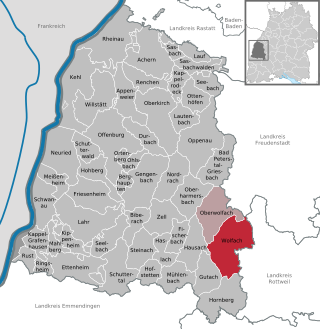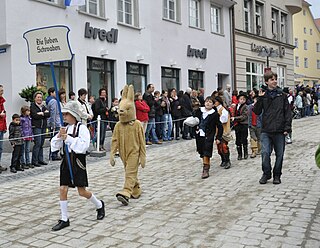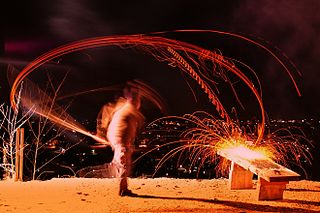Related Research Articles

The Swabian Jura, sometimes also named Swabian Alps in English, is a mountain range in Baden-Württemberg, Germany, extending 220 km (140 mi) from southwest to northeast and 40 to 70 km in width. It is named after the region of Swabia.

Swabian is one of the dialect groups of Upper German, sometimes one of the dialect groups of Alemannic German, that belong to the High German dialect continuum. It is mainly spoken in Swabia, which is located in central and southeastern Baden-Württemberg and the southwest of Bavaria. Furthermore, Swabian German dialects are spoken by Caucasus Germans in Transcaucasia. The dialects of the Danube Swabian population of Hungary, the former Yugoslavia and Romania are only nominally Swabian and can be traced back not only to Swabian but also to Franconian, Bavarian and Hessian dialects, with locally varying degrees of influence of the initial dialects.

Rottweil is a town in southwest Germany in the state of Baden-Württemberg. Rottweil was a free imperial city for nearly 600 years.

Überlingen is a German city on the northern shore of Lake Constance (Bodensee) in Baden-Württemberg near the border with Switzerland. After the city of Friedrichshafen, it is the second-largest city in the Bodenseekreis (district), and a central point for the outlying communities. Since 1 January 1993, Überlingen has been categorized as a large district city.

Wolfach is a town in the Black Forest and part of the Ortenaukreis in Baden-Württemberg (Germany). It is a well-known spa town.

Wilhelm Friedrich Wieprecht was a German musical conductor, composer and inventor.

The Swabian-Alemannic Fastnacht, Fasnacht or Fasnat/Faschnat is the pre-Lenten carnival of Alemannic folklore in Switzerland, southern Germany, Alsace and Vorarlberg.

Swabians are a Germanic speaking people who are native to the ethnocultural and linguistic region of Swabia, which is now mostly divided between the modern states of Baden-Württemberg and Bavaria, in southwestern Germany.

The Carnival of Basel is the biggest carnival in Switzerland and it is the main Protestant carnival in the world. Basler Fasnacht takes place annually between February and March in Basel. It has been listed as one of the top fifty local festivities in Europe.

The Sechseläuten is a traditional spring holiday in the Swiss city of Zürich celebrated in its current form, usually on the 3rd Monday of April, since the early 20th century.

The Großer Zapfenstreich is a military ceremony performed in Germany and Austria. It is similar to the military tattoo ceremony performed in English-speaking countries, and is the most important ceremonial act executed by the German federal armed forces, the Bundeswehr, and by the Austrian federal armed forces Bundesheer. The Zapfenstreich is performed only during national celebrations and solemn public commemorations, to honour distinguished persons present at such special events. Examples are the farewell ceremony for a German federal president, or at the conclusion of large military exercises. It takes place in the evening hours and consists of a military formation of at least one military band, two platoons of armed infantrymen, and two lines of soldiers carrying torches, in total about 400 men.

Bösingen is a municipality in the district of Rottweil, in Baden-Württemberg, Germany.
Forchheim is the smallest municipality in the district of Emmendingen in Baden-Württemberg in Germany.

Hirrlingen is a municipality in the district of Tübingen in Baden-Württemberg in Germany. Hirrlingen is located about 15 kilometers southwest from Tübingen.
Schwalldorf is a suburban district of Rottenburg am Neckar in the administrative district of Tübingen in Baden-Württemberg (Germany).

The Königgrätz March, also known as Der Königgrätzer or Der Königgrätzer Marsch, is one of the most famous German military marches, composed in 1866 by Johann Gottfried Piefke in commemoration of the Battle of Königgrätz, the decisive battle of the Austro-Prussian War, in which the Kingdom of Prussia defeated the Austrian Empire. In Piefke's most successful arrangement of the Königgrätzer Marsch, another march, Der Hohenfriedberger, is used as a trio. The commonly played version is set as an infantry march, while an alternate adaptation is arranged as a cavalry galop. The German military march catalogue also has the "Königgrätzer mit anderem Trio", but this secondary composition is far less recognized.

The Mainz Carnival is a months-long citywide carnival celebration in Mainz, Germany that traditionally begins on 11 November but culminates in the days before Ash Wednesday in the spring.

Guggenmusik is a term widely used in the Alemannic region of Switzerland, Austria and southern Germany to designate both a Carnival marching band and the type of music it plays.

A variety of customs and traditions are associated with Carnival celebrations in the German-speaking countries of Germany, Switzerland and Austria. They can vary considerably from country to country, but also from one small region to another. This is reflected in the various names given to these festivities occurring before Lent.

Scheibenschlagen is a traditional event in Central Europe in which glowing wooden disks are flung from a long hazelnut stick off a mountain side into the valley below.
References
- ↑ "Der Narrhallamarsch | Wissenswertes | Fastnacht". swr.online. September 8, 2011. Archived from the original on July 11, 2020. Retrieved July 9, 2020.
- ↑ "Geschichte Fasnet".
- ↑ Winfried Hecht, Rottweil 1802–1970: Von der Reichsstadt zur Großen Kreisstadt. 1997, p.166
- ↑ "Sechseläuten-Marsch: Sein Weg in die Schweiz - Radio". Play SRF.